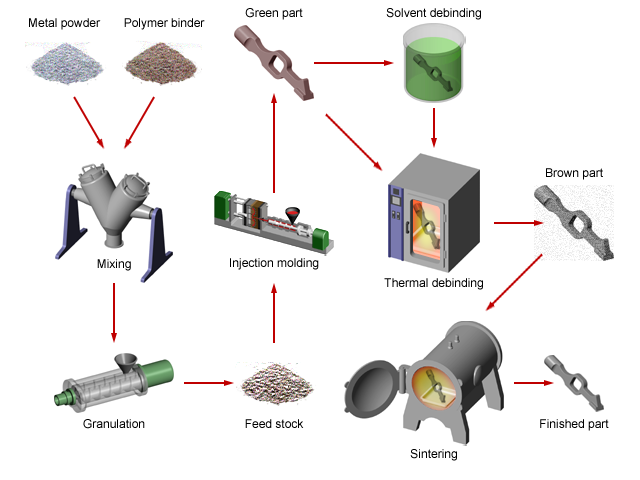How does MIM work?
Metal injection molding (MIM) offers a manufacturing capability for producing complex shapes in large quantities. The process utilizes fine metal powders which are custom formulated with a binder into a feedstock which is granulated and then fed into multiple cavities of a conventional injection molding machine. After the “green” component is removed, most of the binder is extracted by thermal or solvent processing and the rest is removed as the Metal injection moldingcomponent is sintered (solid-state diffused) in a controlled atmosphere furnace. The MIM process is very similar to plastic injection molding and high-pressure die casting, and it can produce much the same shapes and configuration features. However, it is limited to relatively small, highly complex parts that otherwise would require extensive finish machining or assembly operations if made by any other metal forming process.
The Metal Injection Molding Process
Metal injection molding (MIM) offers a manufacturing capability for producing complex shapes in large quantities. The process utilizes fine metal powders which are custom formulated with a binder into a feedstock which is granulated and then fed into multiple cavities of a conventional injection molding machine. After the “green” component is removed, most of the binder is extracted by thermal or solvent processing and the rest is removed as the component is sintered (solid-state diffused) in a controlled atmosphere furnace. The MIM process is very similar to plastic injection molding and high-pressure die casting, and it can produce much the same shapes and configuration features. However, it is limited to relatively small, highly complex parts that otherwise would require extensive finish machining or assembly operations if made by any other metal forming process.
The advantages of the metal injection molding (MIM) process lie in its capability to produce mechanical properties nearly equivalent to wrought materials, while being a net-shape process technology with good dimensional tolerance control. Metal injection molded parts offer a nearly unlimited shape and geometric-feature capability, with high production rates through the use of multi-cavity tooling. MIM touches your life
The limitation MIM is subject to is one of overall part size, with most components generally not exceeding 250 g.
Applications
The window of economic advantage in metal injection molded parts lies in complexity and volume for small-size parts. MIM materials are comparable to metal formed by competing methods, and final products are used in a broad range of industrial, commercial, medical, dental, firearms, aerospace, and automotive applications. Dimensional tolerances of ±0.3% are common and machining is required for closer tolerances. MIM can produce parts where it is difficult, or even impossible, to efficiently manufacture an item through other means of fabrication. Ideally, at least 75 dimensional specifications in a component of just 25 mm maximum size and 10 g mass is best – as for example required for watch cases, cellular telephone plugs, and laptop computer hinges. Increased costs for traditional manufacturing methods inherent to part complexity, such as internal/external threads, miniaturization, or identity marking, typically do not increase the cost in a MIM operation due to the flexibility of injection molding.
Other design capabilities that can be implemented into the MIM operation include product codes, part numbers, or date stamps; parts manufactured to their net weight reducing material waste and cost; Density controlled to within 95–98%; Amalgamation of parts and Complex 3D Geometries.
The ability to combine several operations into one process ensures MIM is successful in saving lead times as well as costs, providing significant benefits to manufacturers. The metal injection molding process might be a green technology due to the significant reduction in wastage compared to “traditional” manufacturing methods such as 5 axis CNC machining. However, some of the older operations generate toxic emissions such as formaldehyde, dispose of chlorinated solvents, and must burn off wax or other polymers, leading to greenhouse gas emissions.
Typical Markets Using Metal Injection Molded Parts—computer peripherals, medical and dental devices, automotive, firearms, electronic packaging, consumer products



